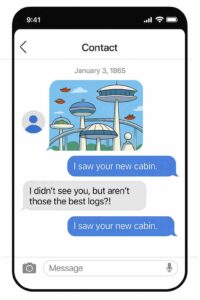Screenshots Are Barely Evidence: How to Authenticate Digital Data in Court
By Steve Burgess, Copyright 2025
Screenshots are convenient. They’re quick, visual, and easy for clients to share — but in the courtroom, convenience can be a trap. Screenshots alone rarely meet the evidentiary standards for authenticity, and relying on them without proper verification can put your entire argument at risk.
Why Screenshots Fall Short
A screenshot is just an image — a flat picture of what was on a screen at a moment in time. It doesn’t prove when that content was created, who created it, or whether it was altered. Anyone with basic photo editing software (or AI tools) can change a screenshot in seconds.
Even unaltered screenshots are missing critical metadata — the hidden timestamps, source identifiers, and digital signatures that courts rely on to establish authenticity.
In other words: a screenshot can illustrate a point, but it can’t authenticate it.
What Courts Expect: Authenticity and Chain of Custody
Under Federal Rule of Evidence 901, digital evidence must be authenticated — shown to be what its proponent claims it is. That usually means demonstrating how it was obtained and verifying that it hasn’t been altered.
A proper digital forensic process includes:
- Verified source acquisition (using forensic imaging tools)
- Hash validation to prove the data hasn’t changed.
- Metadata preservation
- Documented chain of custody
Without these, a screenshot’s evidentiary value drops to near zero.
Real-World Example
In one civil dispute, an attorney submitted screenshots a client saved from her phone as proof of her opponent’s threats. The opposing expert demonstrated that the timestamps didn’t match the date of the alleged event. In this case, the oldest source  had been synced to the client’s iCloud account, where the creation dates of the screenshots were found. The screenshots were excluded, and the case’s credibility took a hit.
had been synced to the client’s iCloud account, where the creation dates of the screenshots were found. The screenshots were excluded, and the case’s credibility took a hit.
Had the data been properly extracted from the device using forensic methods, the messages would have been admissible — and far more persuasive.
Better Alternatives: Forensic Data Extraction
When possible, always collect digital communications and files through verified forensic tools that:
- Capture full context (sender, recipient, timestamps, attachments)
- Preserve metadata and hash values.
- Generate verifiable reports admissible under Rule 901 and 702
- Rule 901 says that the evidence must be authenticated or identified to show it is what it purports to be.
- Rule 702 says that (1) the expert must be qualified; (2) the testimony must address a subject matter on which the factfinder can be assisted by an expert; (3) the testimony must be reliable; and (4) the testimony must “fit” the facts of the case.
For example, forensic imaging of a phone, computer, or cloud account can provide the complete, untampered data set — not just what’s visible on-screen.
In the case of emails (or worse, screenshots of emailed screenshots), not only is the source image unverified, but the email itself would not have been authenticated.
The header information a user sees in an email may include a date, time, subject, sender, and recipient. But these things can be manufactured by something as simple as Microsoft Word, and in any case, do not contain the underlying data to verify that the header information is what it appears to be.
How to Handle Screenshots You Already Have
If your client only has screenshots, don’t panic — but don’t rely on them blindly.
Here’s what to do:
- Preserve the originals (“Zip” them to preserve the metadata it already has, then email them to yourself – don’t edit or crop).
- Note the source and circumstances (who took it, when, on what device).
- Engage a digital forensics expert to verify or locate the original data source.
Often, we can use the screenshots as leads to locate the original files or messages, turning an unreliable image into admissible evidence.
Key Takeaway
Screenshots are a useful visual aid, but not a substitute for authentic digital evidence.
To protect your case, always verify and preserve data properly — ideally with the help of a qualified forensic expert.
